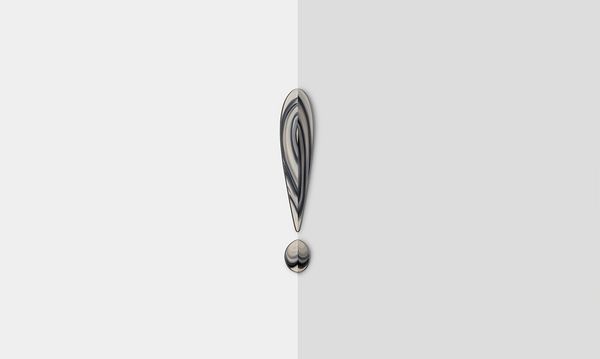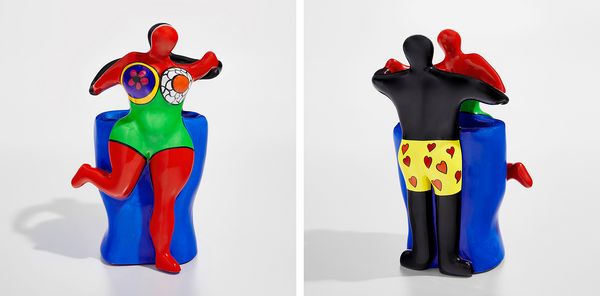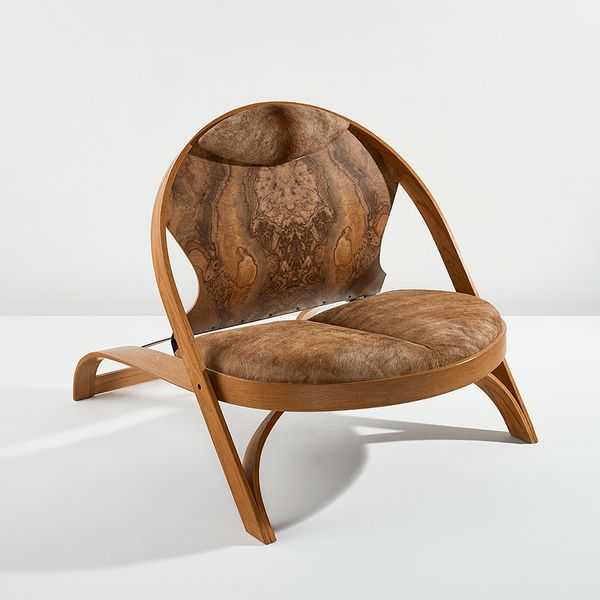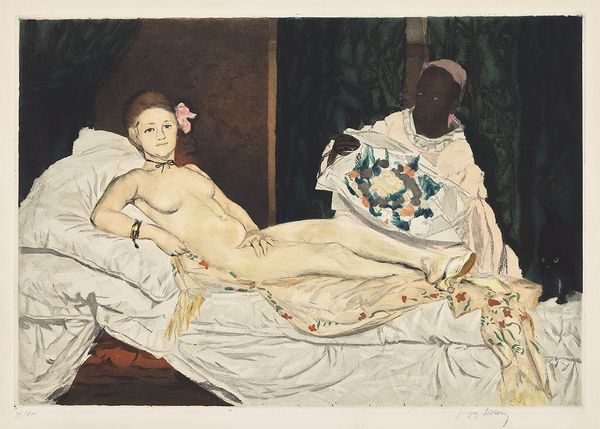Richard Artschwager, Corner Exclamation, 1993. Editions & Works on Paper, New York.
Niki de Saint Phalle
Niki de Saint Phalle, Head with Snake, circa 1985. Editions & Works on Paper, New York.
Niki de Saint Phalle’s works span genres and include monumental and identifiable public sculptures around the globe. Her multiples are highly desirable due to the nature of her process — she demanded her editioned works to be as close to the original as possible. A striking example of the three exceptional works on offer in our New York auction, Head with Snake features an iconic theme for the artist, who returned to snake imagery repeatedly in her oeuvre. Her interest in the figure stemmed from a traumatic early childhood experience and is heightened in this work by rich associations with fertility, wisdom, and rebirth.
Niki de Saint Phalle, Dancing Couple Vase (front and rear), 2000. Editions & Works on Paper, New York.
The artist’s Dancing Couple Vase comes to the sale from the collection of Thomas B. Lehman, the impressively creative collector and noted lawyer for whom Niki de Saint Phalle was an artist of great interest. The work explores another iconic motif for the artist, what she called “nanas.” Calling on the rich associations of the French slang term for “chick,” the motif is used in de Saint Phalle’s unique way to present a modern interpretation of femininity and motherhood. The work is remarkably characteristic of her artistic output, featuring vibrant colors and patterns that express the irrefutable joy synonymous with her “nana” imagery. It also is representative of her 25-year collaborative partnership with Robert Haligon and his family’s business.
Richard Artschwager
Richard Artschwager, Chair/Chair, 1987–1990. Editions & Works on Paper, New York.
The works of Richard Artschwager defy categorization and exist in a universe of contradiction. His work is commonly seen to belong to three vernaculars at once — Pop, Minimalism, and Conceptualism. We see Pop in his use of utilitarian objects, Minimalism in the stark aesthetic and use of industrial materials, and Concept in the impulse to engage with the ideological structures of language and a coolly detached expression. Blurring the lines between the manufactured and the handmade, the functional and the functionless, and the ordinary physical object and the ideas of high art, his works are all these things at once and yet, through Artschwager’s brilliant execution, we just get it.
Chair/Chair is joyously furniture, sculpture, and image all at once. The work showcases his interest in everyday objects and their materiality. It’s a knot of complex contradictions, making use of Formica (one of his signature materials which is itself a depiction of wood). Corner Exclamation is one of many sculptures by the artist that translate punctuation marks into the three-dimensional world. Installed at the intersection of two walls, the work displaces the connotations of the exclamation mark (anger, excitement, pain, fear, etc.), thus transferring the mute authority to an unexpected area of an interior environment.
James Rosenquist
James Rosenquist, F-111, 1974. Editions & Works on Paper, New York.
Born in North Dakota during the Great Depression, James Rosenquist was an artist who understood the sacrifice of labor. He began working at the age of 8 wrapping flowers for a florist. He went on to work as an apple and potato picker and drove a delivery truck, before eventually becoming a sign painter, making billboard-sized ads on the sides of barns along the highway from North Dakota to Wisconsin. He ultimately settled in New York, where he painted billboard ads across Brooklyn and Manhattan. It follows then, that the artist would create work that uses the language of advertisements to critique consumerism. Perhaps he understood that labor is at the heart of American culture.
His early experience as a commercial artist in New York influenced his development as a printmaking artist. He once remarked of his time working in the city, “When I painted billboards, I worked with these old union guys, which made printmaking easy because I know how to work with other people.” Rosenquist’s ideas are on full display in F-111, a work in which the artist said he is questioning “the collusion between the Vietnam War, income taxes, consumerism, and advertising.” The work’s fragmented imagery expresses the sentiment of a terrified post-war American culture. Elsewhere in the sale, Rosenquist is represented by an additional 10 lots, including Skull Snap, a remarkably textured paper pulp and lithographic collage produced in collaboration with the man once referred to as the Henry Ford of printmaking, Kenneth Tyler.
James Rosenquist, Skull Snap (Black), 1989. Editions & Works on Paper, New York.
Jacques Villon
After Édouard Manet, Olympia, 1926–1927. Editions & Works on Paper, New York.
Born Gaston Duchamp (yes, Marcel’s brother), Jacques Villon found himself struggling financially after the first World War. To support himself, the artist spent a decade producing reproduction engravings, including of many key works by contemporary painters. Just as the poet from whom Villon borrowed his pseudonym attempted to locate the snows of yesteryear, so too did Villon diligently and painstakingly create faithful reproductions. The work was so laborious it often would take 3–6 months of collaboration between Villon and workshops before the works reached a print run.
Today, the results of these efforts are staggeringly faithful reproductions of 19th and early 20th century paintings from a crucial figure in 20th century art priced at estimates that make them extremely hot on the market. Of particular note is Villon’s Olympia etching and aquatint after Édouard Manet, the original of which requires no introduction and is currently making waves on view at the Metropolitan Museum of Art’s exhibition Manet/Degas — its first visit to the United States. Also in the sale are further Villon works made in this manner, including those after Manet’s Le Déjeuner sur l’herbe and after works by Signac, and Matisse.
Discover More from Editions & Works on Paper, New York >
Recommended Reading
More Radical than Meets the Eye >
It’s Halloween at The Factory >






